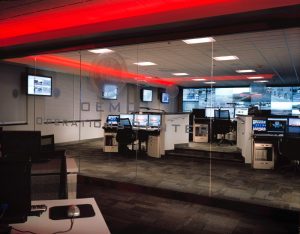11/16/2004
Mayor Richard M. Daley today officially opened the Office of Emergency Management and Communications’ new Operations Center, the City’s central command post to manage and coordinate major events and emergency response.
The Mayor was joined by OEMC Executive Director Ron Huberman and representatives of the key agencies that will coordinate departmental activities from the Operations Center: the Chicago Police Department, Chicago Fire Department, Chicago Transit Authority, and the Departments of Transportation, Streets and Sanitation and Water Management.
“City agencies now have a single command center, so they can work together more efficiently to prevent, prepare for and respond to incidents and emergencies happening throughout the city,” Daley said.
“This center will provide our managers with the information they need to deploy emergency personnel and vehicles to the places where they’re most needed. And that’s important, because the key to dealing with an emergency is not just manpower, it’s having the manpower in the right place at the right time with the right information.”
The 2,000-square-foot, cutting-edge structure, known as the “OC” by its users, features the latest in design innovations and is equipped with advanced systems that maximize the communications efficiencies of City department operations.
Thirteen concentric-arc workstations are equipped with three UXGA 20-inch flat screens with the ability to access City department databases and more than 2,000 cameras located throughout Chicago. Another 250 video cameras, monitoring areas of critical infrastructure, will be added to the network soon.
The stations will have many forms of audio and visual monitoring that integrate seamlessly into the command consoles. The computer consoles are served by a main network where database information is centrally stored and shared between OC participants
City teams will be able to monitor traffic, weather and other situations on a high-resolution digital video wall that can manage and display multiple computer and video sources involved in the City’s day-to-day operation.
A graduated floor in the center of the room will be manned by a designated City Watch Manager who will coordinate and manage the response to various incidents.
“These communications capabilities will deliver real-time interactive connectivity between City departments and strengthen the flow of information exchange resulting in a more efficient manner of deterring, detecting or preventing emergencies or potential threats,” Huberman said. “Using a robust information management system to implement and track events will limit the damages and speed the recovery process.”
The OC allows participants to share information, make decisions, and deploy resources without being physically present. Web-enabled software provides video conferencing capability at each console allowing managers to evaluate event information from both inside and outside the OC.
911 computer-aided dispatch operations will also be integrated with the OC to map and analyze emergencies and can be graphically presented to estimate, evaluate and assist in the decision-making response to an incident.
Other images that will be active on video screens include a computer-based link to the National Weather Service that monitors the most up-to-date weather information, as well as FAA flight track data.
The new Operations Center is a multi-agency center anchored by the Office of Emergency Management and Communications and is the City’s most aggressive step in an ongoing effort to collect intelligence, share information, make decisions and deploy resources through technology integration.
The project was funded through homeland security grants. The contractor was McClier/DMJM Chicago. Women’s and minority business enterprises received 42 percent of the contracts. Fifty percent of on-site constructio
